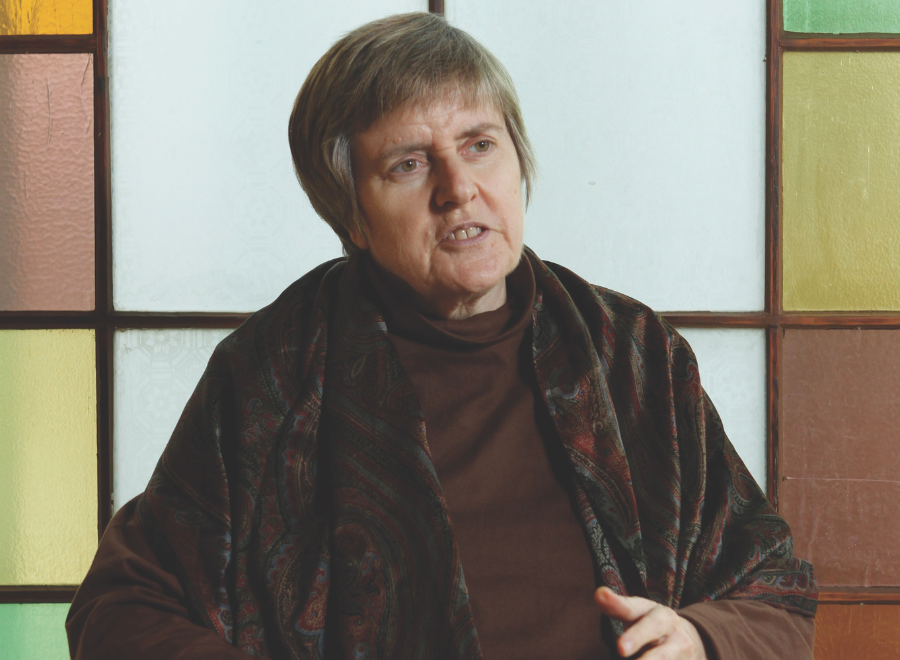Kathleen Norris is an American essayist and poet whose work explores the life of faith. Her bestselling memoirs include Dakota: A Spiritual Geography and The Cloister Walk. She talked to Alicia von Stamwitz about writing, monastic spirituality and mysticism.
Alicia von Stamwitz: The success of your books launched your career as a public speaker. What do you most enjoy speaking about?
You may unsubscribe from any of our newsletters at any time.
Kathleen Norris: I’d say it’s two things. The first is sharing poetry with people, especially audiences that don’t think they will enjoy it because of the way it’s been taught to them or whatever. My favourite audience was at a bull sale in North Dakota, and I also once read poetry to a group of state legislators. In both cases, I picked poems that I knew would go over, that they would respond to. I wanted to give them a good experience of poetry, because almost everybody has had bad experiences with it.
The other thing, especially with Christian audiences, is talking about ancient Christian literature. If you’re a medievalist or a student of monastic history, you would know something about the desert fathers and mothers, but if you’re an ordinary Christian, you probably haven’t heard of them. So it’s really fun to share [the early theologians] because they’re much more accessible than contemporary theologians. It’s powerful stuff.
AvS: Can you give an example?
KN: Yes, one of my favourite passages from [the fourth-century theologian] John Chrysostom was quoted recently. He was called “the golden mouth” because of his reputation as a preacher, and the thing about him is that you can take passages from his homilies and read them to people now and they go, “Wow.” He’s very concrete and vivid. He said — and this is one of the reasons he got exiled from Constantinople — “You’re having your maids collect your excrement in silver basins while a man made in the image of God is freezing to death on the street!” Boom. He got in trouble with the empress because that homily was probably directed at her. She probably had her nice silver bowl for her poop.
And the person I probably connected with the most is Evagrius the monk; that’s the whole genesis of my latest book, Acedia & Me. I wish I could thank him, but he died in 399, and anyway I’m not sure what he would think of this crazy woman coming up to him in the desert. But that was one of the great joys of my book tour — going on public radio and talk shows and saying, “You’ve got to read this guy. He’s really great!”
AvS: You’re a Protestant Christian, but you’ve been associated with Roman Catholic monks for over 30 years. What’s that been like?
KN: Well, when I first encountered the Benedictine monks, I was on a religious search of some kind. I wasn’t sure if I was even a Christian and all of that. I think it’s one of God’s gifts to me that I found this tradition of communal prayer — the Psalm readings, you know, and monastic spirituality. A lot of what I’m talking about is included in Benedictine material, but it comes from a time when there weren’t any divisions in the church. There was no Roman Catholic Church versus Eastern Orthodox versus Protestant. It all stems from the original taproot of the religions, so it’s really accessible to anyone, and that’s how I’ve always felt as a Protestant. The monastic tradition is mine, too.
AvS: If the monastic tradition is accessible to anyone, why do you think so few know about it?
KN: I was just talking to an audience about this. I once saw an ad that a woman had taken out in a newspaper, and she said, “As a western European, I have no tradition.” She was looking for Indigenous Americans who could help her discover their tradition. That’s a very American thing to do, just buy somebody else’s tradition and claim it as yours. But what really struck me is that she was writing off western Christianity. To her, it was “no tradition.” Part of that is how Christianity was taught. If it was crammed down your throat, or if you were told, “This is what you have to memorize” — you know, the catechism and things like that — it can make it seem so meaningless, and so when you’re an adult, you really don’t know what’s there.
I think of the monastic tradition as an underground stream. It’s always been there, but it hasn’t been the main emphasis in the West. Even when you look at someone from the Middle Ages like Thomas Aquinas . . . I mean, he wrote all of that very analytical philosophy, but he also wrote mystical poetry. Of course, nobody thought that was a contradiction back then. You could be a scholastic philosopher and a poet.
AvS: What would be your definition of a mystical poet?
KN: Oh, boy. Well, if you look at Aquinas when he’s trying to figure things out, he’s using very rational categories for everything. But when he’s writing mystical poetry like Pange Lingua, he’s not trying to figure things out, he’s sort of standing in awe and expressing these feelings of wonder about things that we’re not capable of grasping and understanding. It fascinates me that he was so comfortable doing both, you know?
AvS: You’ve been called a mystic. Why do you think that is?
KN: I think all poets have something of the mystic about them, because you write a line and you think, “Gee, I don’t understand that, but it sounds good and I wonder if there’s something there.” You’re not operating on a strictly rational level at all, but then you discover that, yes, that does mean something, and I’m not sure what, but it means something. And then you write another line, and you find a reader that says, “Yeah!” So it is sort of a mystical process in the sense that it doesn’t make sense on a linear level. I think almost all poets have some access to that kind of thinking.
AvS: You once said, “If we walked around totally aware of God’s presence at all times, we’d be lunatics.” What did you mean?
KN: We wouldn’t get anything done! There are times when, yes, it’s wonderful if you can have that kind of experience where you are just rapt in wonder admiring a small baby or the beauty in nature. It doesn’t always happen, but sometimes you do sort of feel transported. . . . The world seems other than it did, say, when you woke up in the morning. Of course, one of the famous examples is Thomas Merton on the street corner in Louisville, and I had a similar experience at Penn Station in New York. It was just Penn Station — I mean, it isn’t even a beautiful station like Grand Central; it was low season and a crappy environment — and I was just looking at all these people and thinking, “Oh my God. God loves all these people. God makes them and loves them.” It was this really intense feeling. I just was taken away with the wonder of it all.
I think most of us have some inkling of that, and I think the point is not the experiences, because they’re fairly commonplace, but what you do about them. How do you reflect them, and what do they mean to you? Do they change your life in any way?
***
This story first appeared in The United Church Observer’s April 2012 issue with the title “‘I think of the monastic tradition as an underground stream.”













